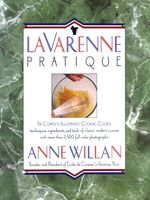Advertisement
Puff Pastry
By Anne Willan
Published 1989
Puff pastry (Fr. pâte feuilleté) is raised by literally hundreds of layers of butter that are interspersed with a flour and water dough. In the oven, the butter melts, detaching the dough layers, while the water turns to steam, lifting the pastry to three or four times its original thickness. There are quicker versions of puff pastry, such as British flaky and American quick puff, but none so light and rich as puff pastry, and none so challenging to the cook.
Exact proportions for puff pastry are fixed by weighing the dough, or détrempe, after mixing, then adding half its weight in butter. The détrempe is made European-style by sifting flour on to a work surface, adding water, salt, and a tablespoon or two of butter (sometimes more), and perhaps a teaspoon of lemon juice to help cut the gluten. Elasticity is the bane of puff pastry and is accelerated by repeated rollings. Therefore, when a hard wheat flour is used, as in the United States, cake flour may be substituted for up to a quarter of the volume of regular flour in order to counter the flour’s gluten. The ingredients are mixed to form a soft, slightly sticky dough. This is wrapped around the additional butter, which has been pounded with a rolling pin so that it is pliable, making the two easy to roll together.


